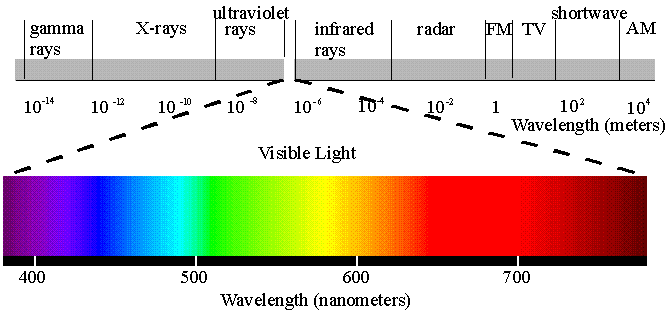Natural light from wavelength of 400~700nm is most suitable for the growth of aquatic plant, but wavelength less than 400nm, also called ”Ultra-violet rays” has side-effect on the growth of aquatic plant. 7% of ultraviolet rays can be classified into three categories: 3% of C class ultraviolet rays (UVC: 200~280nm) and 9% B class ultra-violet are harmful to the majority of aquatic plants; 88% of A class ultraviolet rays (UVA: 320~380nm) is good for aquatic plants, it is able to make leaves become thick, meanwhile it also functions as sterilization for plants.

There are three kinds of lights which is most influential to aquatic plant: ultraviolet ray, visible light and infrared ray.
Ultraviolet rays is a kind of light with big thermal energy, but some part of ultraviolet are absorbed by ozone layer; so what we concerned more is that matters much to the growth of plant: UV-B (280 – 320nm) and UV-A (320 – 380nm), they are helpful to the coloring of plant.
Visible light ranges from 400-700nm, including blue, green, yellow and red light, they are also called “PAR”, i.e. Photosynthesis Active Radiation, it is the most important part for the photosynthesis of plants; among them blue and red are the most important part for the growth of plant, as riboflavin of plant is able to partially absorb it, however, green light not.
Infrared rays (IR) consist of near IR and far IR. Near IR (780 – 3000nm) usually has no positive effect to the plant, it only creates thermal energy; Far IR (3000 – 50000) is not directly from sunlight, it is a kind of radiated rays generated by thermal molecule, and dispersed quickly at night time.
The most sensitive sphere of light spectrum to the plant is from spectrum of 400 ~ 700nm, and 45% sunlight energy are from this sphere, so it is possible to make artificial light source for plant growth, and the light is as close as possible to the sphere of spectrum.
Photon energy varies from different wavelengths, for example, 400nm (blue light) is 1.75 times in thermal than 700nm (red light), however, the two wavelength have same effect on the growth of plant during photosynthesis; the lights in blue light spectrum that cannot be absorbed in photosynthesis of plant will transform into thermal energy. In other words, the photosynthesis rate of aquatic plant is decided by quantity of photon that aquatic plant absorbed in 400 ~ 700nm, not quantity of photon that generated by each wavelength in light spectrum; but it is generally recognized that it is the color of light that has the influence on the photosynthesis rate, but for aquatic plant, the sensitiveness still varies because of special absorption of pigments in leaf, of which chlorophyll is well known to all. However, chlorophyll is not the only useful pigment in photosynthesis, other pigments still get involved, so the efficiency of photosynthesis is not advisable to consider absorption of chlorophyll only.
The way of photosynthesis has little relationship with color of light. Light energy is absorbed by chlorophyll and carotene, it converted to glucose and oxygen through the two photosynthesis systems in fixed water content and carbon dioxide, the photosynthesis process will utilize all visible lights, so all lights have same effect on the photosynthesis of plant.
Some researchers hold that orange color (600-610nm) is significantly positive to the photosynthesis, but it does not mean that plant should be under exposure of such orange light only; the plant still need different balanced light source in terms of morphology formation.
Blue light (400~500nm) is very important to the differentiation and spiracular regulation of plant; if there inadequate blue light but too much red or far IR, stalk of plant will grow excessively, which is easy to cause etiolation. The ratio of light energy between red spectrum (655 ~ 665nm) and far IR (725~735nm) is better to be 1.0 or 1.2, the plant will grow healthy. However, different plant has different sensitiveness to the light spectrum.